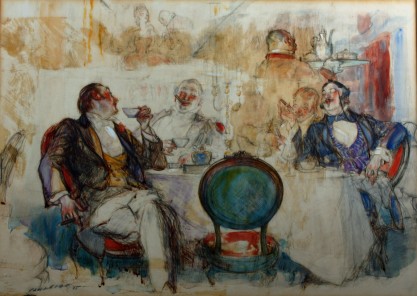



A bustling signed and dated 1925 original advertising gouache painting by noted Golden Age illustrator Henry Patrick Raleigh for Maxwell House Coffee. An opulent high society Great Gatbsy-esque scene which creates focal points around the coffee cups and serving platters in the hands of tony patrons and servers. Raleigh worked on Maxwell House’s print campaign for over a decade, and this shows all the hallmarks of his work for the brand.
The illustration is handsomely framed behind glass and displays well, but does exhibit some condition concerns such as toning to the illustration board and a couple of splits in the illustration board upper middle. Priced accordingly, this is a tremendous example by this important and iconic American artist and illustrator.



A capsule biography of the artist: For almost thirty years, most issue of the Saturday Evening Post featured the drawings of Henry Raleigh. In all he was called upon to illustrate over five hundred Post stories for such revered authors as Stephen Vincent Benet, William Faulkner, Sinclair Lewis, and Somerset Maugham.
Raleigh was considered the High Society Illustrator of the “Gatsby Era”. He was the favorite artist of F. Scott Fitzgerald and Agatha Christie who chose Raleigh to illustrate stories.
• At 17 he got his first job, as an artist, with the San Francisco Bulletin newspaper. He was an “on the scene” newspaper artist and reporter.
• William Randolph Hearst discovered Henry and asked him to relocate to New York City to work for the Journal.
• Raleigh covered all of the society events to sketch the well-dressed men and beautiful women of New York society.
• By the time he was 25 he was one of the highest paid newspaper artist in America. And, this work only required him to work 3 days per week.
• He decided to branch out to illustrate stories for national monthly magazines.
• Early assignments came from Vanity Fair, Harper’s Bazar, Collier’s and Saturday Evening Post.
• In 1914 Raleigh was chosen by Collier’s to provide illustrations for a five-part serialized story by the most popular author of the period, H. G. Wells. The “Bealby” story was immensely important for Collier’s and overnight made Raleigh one of the most sought after illustrators in America.
• In 1917 WWI was in its third year and Raleigh’s “Hunger Poster” was selected by the government for a distribution of 5 million copies.
• The 1920’s was age of optimism. The magazines of the period grew in readership and profitability and so did the artists. Raleigh worked at a feverish pace.
• During the depression, and for three decades, his average income was well over $100,000 per year. He was one of the highest paid illustrators America and perhaps the word. And, he was often been referred to as the most prolific commercial artist of the period.
• By his forty-third year, as a commercial artist, he had published over 20,000 illustrations.
• In a 1925 article “Rebounded Art Critic”, Evert Shinn proclaimed him “America’s greatest illustrator”.
• He enjoyed the life of a celebrity and took on the attributes of high society that was the subject of his art. He had a wonderful wife and beautiful children; several homes; yachts; and most years he traveled abroad. He typically devoted eight months a year to his career as an artist.
• He was the star of the famous Westport, Conn, art colony.
• But this lifestyle came to an abrupt end in when 1939 Saturday Evening Post restyled their magazine to take advantage of their new printing equipment that could print color photographs. The Golden Age of Illustration was over and most of the magazine illustrators were out of work.
• Henry Raleigh’s career quickly spiraled out of control. He was too proud to ask for help and could no longer support his extravagant lifestyle. In 1944 he took his own life by jumping from the window of his Manhattan hotel.


